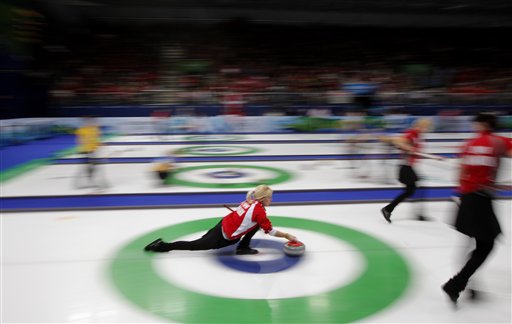The Olympic sport of curling is much harder than it looks

Denmark's Madeleine Dupont delivers the stone in a women's curling match against Canada at the Olympics on Friday. (Photo: Associated Press)
It has people moving around, a scoring system not always explained well and is something Americans are clearly not experienced at.
Yet every four years, curling fascinates us during the Winter Olympics.
Curling is the most misunderstood sport in the Winter Olympics. Its scoreboard looks like baseball. Its playing surface and delivery of the stones looks like shuffleboard.
Yet it is much more complicated. It requires more balance, timing and team coordination to curl successfully. Players wear shoes called grippers to maneuver around the ice and use brooms that can cost $80 to 180 to sweep the ice, causing friction on the pebbled ice surface to make the stone go farther. When a curler is delivering a stone, one of the shoes - depending on whether you are right or left handed - is replaced by a slider, with a Teflon bottom to help the deliverer glide more on the ice.
When the stone is thrown, the goal is to make it to the “house,” which is essentially the scoring zone. At the end of an end, whoever is closer to the button - the middle target of the ringed scoring zone - receives a point. If a team has two stones closer to the button than another team, they get two points.
It may also be the most friendly sport in the Winter Games. Before each match, everyone shakes hands and says “Good curling” at the Detroit Curling Club in Ferndale.
After matches, the tradition is to buy each other beers.
Curling well, though, is anything but simplistic. Frankly, it’s hard. You realize that as you find yourself planted on your butt trying to glide across the ice after chasing after a stone.
You realize it after you try to deliver the rock and the motion is so unfamiliar you end up placing some of your weight on the stone - sending it precisely nowhere.
But the everyman nature of it allows almost everyone to think they can participate. And they can. Even if they do it poorly.
It’s why when the Detroit Curling Club had an open house after the 2006 Turin games, when curling started to pick up more popularity nationally, club member Mark McElwee said people lined up out the door to have the opportunity to throw a stone.
Then, he said, they’d go to the back of the line to try it again.
It’s easy to understand why.
There’s something mildly addictive about this sport. Maybe it’s the drive to deliver a stone just right - something akin to putting everything together for a perfect golf swing - or maybe it’s that while it looks so easy when you try it is really isn’t.
My instructor for the brief time I curled Wednesday, Linda Duby, assured me I did better than most in their first few times delivering stones.
I was able to send the stone halfway down the ice. I had the motion somewhat down, save for dragging my heavy leg onto the ice and leaning too much on the stone, slowing my momentum.
Sweeping seemed a little bit easier, although moving quickly and trying to create friction in a concentrated area can prove difficult on a sheet of ice.
Soon enough, the time was up and the 8 p.m. league at the Detroit Curling Club, which as been around in some form or fashion since 1885, started its matches with the typical “Good curling” greeting. On the far sheet of ice, McElwee’s team was training for the national club tournament.
And McElwee might be the epitome of curling in America. He drives from Lansing to Ferndale as often as he can to curl at Joe Livermore Arena - the closest place he can find.
This is the life of an emerging sport. It’s all about your own passion - and finding people who are willing to share it with you.
At the Detroit Curling Club, there is no question about that.
Proper curling form:
Michael Rothstein covers University of Michigan sports for AnnArbor.com. He can be reached at (734) 623-2558, by e-mail at michaelrothstein@annarbor.com or follow along on Twitter @mikerothstein.


Comments
Matt Sussman
Mon, Feb 22, 2010 : 3:48 p.m.
Ann Arbor absolutely needs a curling club. It's nice that Ferndale has some sheets, and Bowling Green CC is about equally as far away, but I'd love to see some interest in this city to get some curling ice appear somewhere in town.